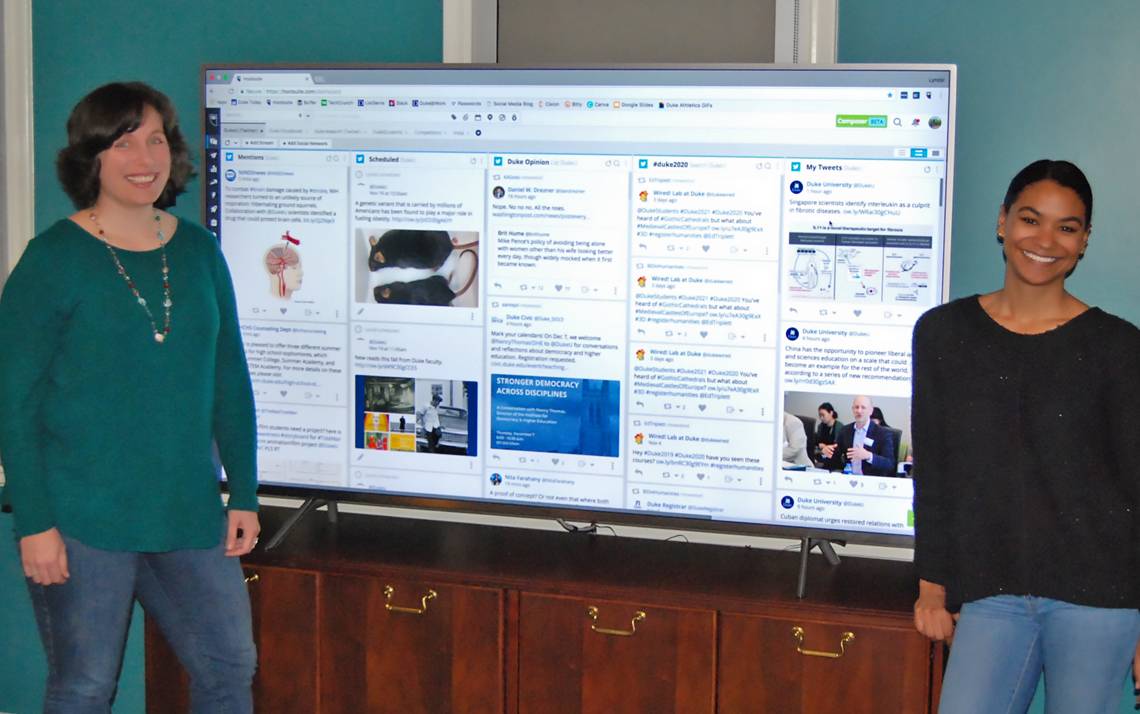How to Build Your Professional Brand
Choosing the right network for you and creating your own personal webpage are some pointers suggested by Duke experts

Christina Kelley, an annual giving officer for Duke, didn’t know where to begin when she was tasked with building a social media presence as a volunteer for a non-profit.
She attended “Managing Your Online Presence," a free Learn IT @ Lunch workshop through the Office of Information Technology and left realizing she needed only one digital platform – Facebook – for Resources for Reservists, which provides financial resources for members of the United States Armed Forces Reserves.
“You should start out with one you’re comfortable with,” Kelley said. “I thought that was so clever. I am not prepared to manage five different accounts and make sure they’re active all the time.”
Looking to enhance your professional brand or share your organization’s story? Here are five tips from Duke experts:
Choose the right network for you
On Twitter, you’ll find Mark Anthony Neal sharing his writing and other articles he finds interesting. On Facebook, you’ll catch him engaging in conversations about current events. On Instagram, he posts photos of his life, like the books he’s reading and restaurants he’s visited.
“I’ve always been open to emerging platforms for reaching an audience,” said Neal, a professor of African and African American studies at Duke. “Social media is about sharing content and generating recognition for writers and topics of interest to me.”
Sonja Likness Foust, director of social media and content strategy in the Office of News & Communications, suggests matching interests and objectives with platforms.
Do you take pictures? Maybe Instagram is for you.
Do you write a blog? Twitter and Facebook can help you share your content.
Are you looking to network and connect with people in your field? LinkedIn builds your professional community.
In the Office of News & Communications, Foust uses Facebook to reach staff, faculty, parents and alumni; YouTube and Snapchat for prospective students; and Instagram and Twitter for current students.
“Ultimately, decide on what platform is most comfortable for you,” Foust said. “You’re not going to be as successful if you’re forcing yourself to adapt.”
Choose a good headshot
Don’t be an egg – that default image for Twitter users who don’t upload a headshot.
Use a high-quality headshot for your networks, particularly for LinkedIn.
Megan Mendenhall, a photographer for Duke University, recommends a well-lit, clutter-free background.
“You want folks to focus on you, not the background,” she said. “It’s the same reason that you wouldn’t wear mismatched clothes.”
For clothing, Mendenhall recommends solid blues, reds, greens and pastels, all of which photograph well.
“Having a photo of yourself with a nice friendly smile does tend to leave a nice first impression with the people who you’re interacting with who you haven’t met in person,” Mendenhall said.
Remember, it’s public
 Foust said everything you post is public and associated with your name. Social media can advance a career but inappropriate or disrespectful content can also get you in trouble.
Foust said everything you post is public and associated with your name. Social media can advance a career but inappropriate or disrespectful content can also get you in trouble.
“It’s not that you can’t think about being edgy or funny or silly,” Foust said. “Just refrain from putting stuff out there you wouldn’t want your current or next employer to see.”
Another way to keep it respectful is to ignore negative digital trolls who comment on your posts. Don’t get angry or frustrated and unleash the fury in a response.
“It’s better to just not engage with them,” Foust said.
Follow along
Lyndsi Lewis, senior social media strategist for the Office of News & Communications, said a helpful way to ease into Twitter is to follow conversations by searching for a hashtag like #HESM, which stands for “higher education social media.”
On social media, a hashtag (#) before a word or phrase categorizes posts and photos. By clicking on a hashtag, users can see content with incorporated acronyms, words or phrases.
Duke has been following, sharing and collecting photos of campus during the Fall season using #DukeFall. During admissions season, they’ll use #Duke2022 to welcome the incoming class.
“You don’t have to position yourself as an expert. You don’t even have to post right away,” Lewis said. “Monitoring certain hashtags or topics online is a great way to stay on top of what’s going on in your field, familiarize yourself with established thought leaders, and ease into using a new social platform.”
On LinkedIn, you can follow along by joining special interest groups.
Gina Rogers, a practitioner with Duke’s Learning and Organization Development, uses LinkedIn special interest groups such as “Organization Development Network” to follow topics in her field and learn about others.
“It lets me have my ear and eye on what multiple professions are talking about” she said. “It gives me a talking point for when I meet people.”
Create a site – a blog, website or personal homepage
Neal, the professor of African and African American studies, purchased the domain name “New Black Man in Exile,” the name of one of his books, about two years ago. He decided to buy it from Google Domains so people searching for his name and work would be directed to his website.
He uses “New Black Man in Exile” to share his writing, as well as others’ work about race, sports and culture.
“I’m very proud of being able to present the wholeness of who I am as a thinker, scholar and man,” Neal said.
Foust said buying your domain name or creating a website with your name can help people find your content when they search your name. Duke employees and students can also create their own websites at no charge through Sites@Duke. There are also a host of other blog platforms like Tumblr and WordPress.